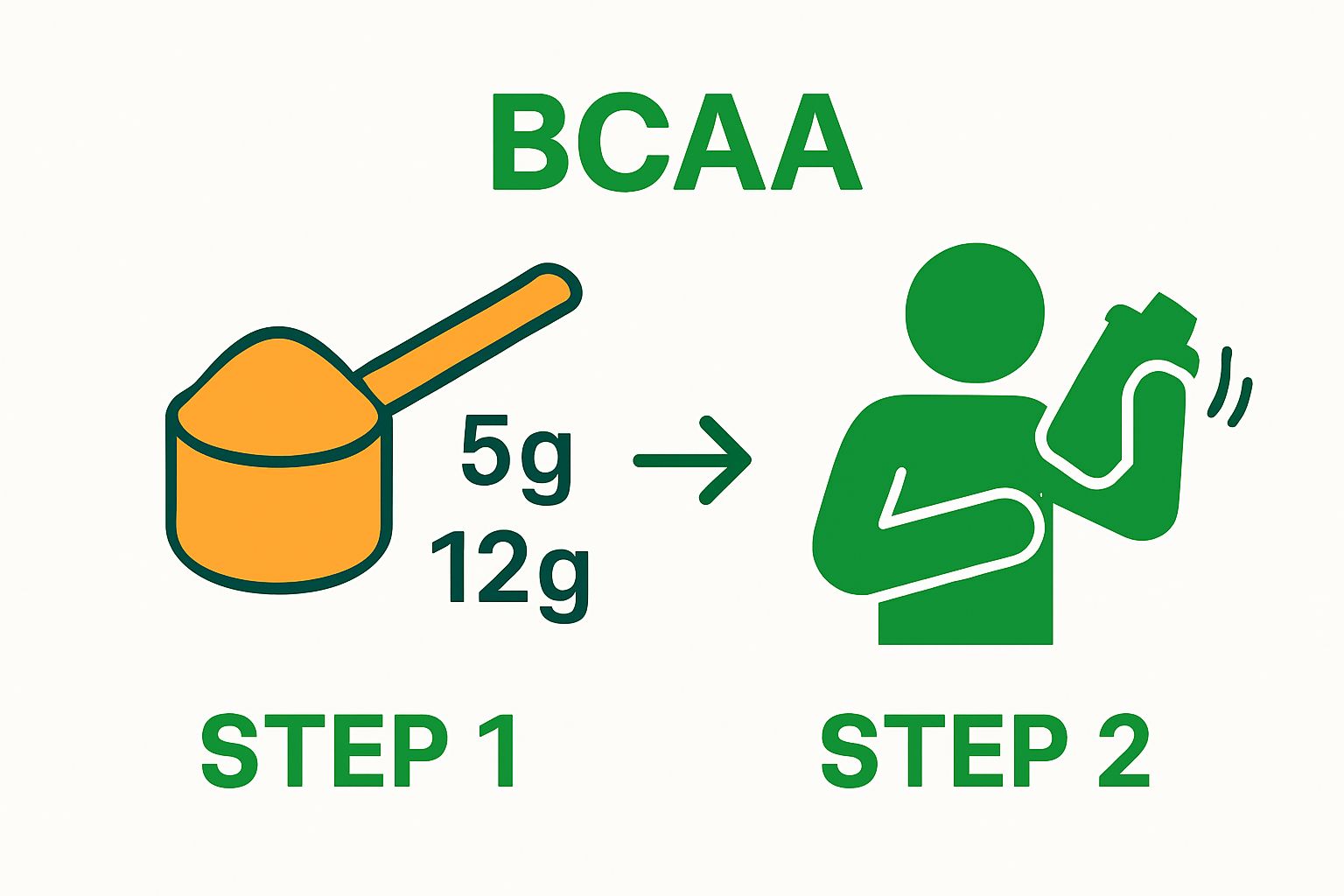Protein and BCAA supplements are always on the minds of athletes searching for faster recovery and muscle growth. But surprisingly, many still guess their intake or timing without real science behind it. Research shows that athletes should aim for 1.6 to 2.2 grams of protein per kilogram of body weight every day for best results. This means getting your numbers right matters more than picking the fanciest supplement or downing it at random times.
Table of Contents
- Step 1: Determine Your Daily Protein Needs
- Step 2: Choose the Right BCAA Supplement
- Step 3: Decide When to Take BCAAs
- Step 4: Measure the Correct Dosage
- Step 5: Mix and Consume the Supplement
- Step 6: Monitor Your Body’s Response
Quick Summary
| Key Point | Explanation |
|---|---|
| 1. Determine your protein needs | Calculate protein intake based on body weight, aiming for 1.6 to 2.2 grams per kilogram for optimal muscle recovery. |
| 2. Choose high-quality BCAA supplements | Select supplements with a 2:1:1 ratio of leucine, isoleucine, and valine for effective muscle protein synthesis. |
| 3. Optimize timing of BCAA intake | Consume BCAAs before, during, and after workouts to maximise absorption and recovery efficiency. |
| 4. Measure accurate dosages | Aim for a daily intake of 5 to 12 grams of BCAAs, adjusting based on body weight and training intensity. |
| 5. Monitor body responses diligently | Track recovery speed and muscle soreness to assess the effectiveness of BCAA supplementation and adjust as needed. |
Step 1: Determine Your Daily Protein Needs
Determining your daily protein needs is the critical foundation for effectively using BCAA supplements and supporting muscle recovery. Protein intake plays a pivotal role in muscle protein synthesis, and understanding your specific requirements helps optimise supplement strategy. Your protein needs vary based on multiple physiological factors, including body weight, activity level, fitness goals, and overall training intensity.
To calculate your precise protein requirements, fitness professionals recommend using your body weight as a primary metric. Generally, athletes and individuals engaged in regular strength training should aim for 1.6 to 2.2 grams of protein per kilogram of body weight daily. For example, a 75kg athlete would target approximately 120 to 165 grams of protein per day. Read more about protein intake strategies in our comprehensive protein guide.
Your calculation should also account for training frequency and intensity. Endurance athletes might require slightly different protein profiles compared to strength trainers. Those performing high-volume resistance training or experiencing significant muscle breakdown will need higher protein intake to support recovery and muscle growth. Consider tracking your protein consumption using nutrition apps or food journals to ensure consistent intake.
Specialist nutritionists recommend spreading protein consumption across multiple meals rather than consuming large quantities in a single sitting. This approach promotes better amino acid absorption and maintains a consistent muscle protein synthesis environment. When integrating BCAA supplements into your nutrition strategy, remember they complement your total protein intake and should not be considered a complete protein replacement.
Step 2: Choose the Right BCAA Supplement
Selecting the appropriate BCAA supplement is crucial for maximising muscle recovery and achieving optimal fitness results. Not all BCAA supplements are created equal, and understanding key selection criteria can significantly impact your nutritional strategy. Learn more about amino acid supplement insights in our comprehensive guide.
The most critical factor in choosing a high-quality BCAA supplement is examining its amino acid profile. Professional athletes and sports nutritionists recommend seeking supplements with a 2:1:1 ratio of leucine, isoleucine, and valine. This specific proportion mirrors the natural composition found in muscle tissue and has been scientifically demonstrated to support muscle protein synthesis most effectively. Leucine, in particular, plays a pivotal role in stimulating muscle growth, so prioritise supplements where leucine is the dominant branched-chain amino acid.
Beyond the amino acid ratio, examine additional supplement characteristics that enhance overall quality. Look for products that are free from unnecessary additives, artificial sweeteners, and fillers. Opt for supplements that provide transparent labelling, indicating precise amino acid quantities and ingredient sources. Powder formats often offer more flexible dosing compared to capsules, allowing you to adjust intake based on your specific training intensity and recovery needs. Consider your personal preferences regarding taste, mixability, and convenience when making your selection. Some athletes prefer flavoured supplements for enhanced palatability, while others prioritise unflavoured options that can be easily mixed with other drinks or protein shakes.
Below is a summary table outlining the key criteria and features to consider when selecting a BCAA supplement, as described in the guide.
| Selection Criteria | Details/Advice |
|---|---|
| Amino Acid Ratio | Opt for a 2:1:1 ratio of leucine, isoleucine, and valine |
| Leucine Content | Leucine should be the dominant amino acid for optimal muscle protein synthesis |
| Additives and Fillers | Choose products free from unnecessary additives, artificial sweeteners, and fillers |
| Labelling Transparency | Look for precise labelling of amino acid quantities and sources |
| Format | Powders allow more flexible dosing compared to capsules |
| Taste and Mixability | Consider flavoured or unflavoured options based on personal preference and ease of mixing |
| Brand Reputation | Favour brands known for consistent quality and third-party testing |
Consider consulting with a sports nutritionist or conducting thorough research to identify reputable brands known for consistent quality and third-party testing. Your chosen BCAA supplement should complement your existing nutrition plan and support your specific fitness goals, whether that involves muscle building, endurance training, or accelerated recovery.
Step 3: Decide When to Take BCAAs
Timing your BCAA supplement intake can dramatically influence its effectiveness in muscle recovery and performance enhancement. Strategic consumption is more important than random supplementation. Explore more about amino acid performance strategies.
Most sports nutritionists recommend consuming BCAAs during three critical windows: before exercise, during training, and immediately post-workout. Pre-workout consumption, typically 15-30 minutes before training, can help reduce muscle protein breakdown and provide immediate amino acid availability. This approach is particularly beneficial for individuals training in a fasted state or engaging in prolonged, intense exercise sessions. During extended workouts lasting over 60-90 minutes, consuming BCAAs can help maintain muscle energy and potentially reduce fatigue.
Post-workout supplementation represents the most crucial timing for muscle recovery. Consuming BCAAs within 30 minutes after completing your training session supports muscle protein synthesis and helps initiate the recovery process. The immediate post-exercise period is when muscles are most receptive to nutrient absorption, making it an optimal time to replenish amino acid stores. Some athletes also benefit from a small BCAA intake between meals to maintain a consistent amino acid profile throughout the day, which can support ongoing muscle maintenance and growth.
Individual variations in training style, metabolism, and fitness goals mean there is no universal perfect timing. Experiment with different consumption windows and monitor your body’s response. Track metrics like muscle soreness, recovery speed, and overall workout performance to determine the most effective BCAA supplementation strategy for your unique physiological needs. Consistency in both timing and dosage will ultimately yield the most significant results in muscle recovery and performance optimization.
Step 4: Measure the Correct Dosage
Precision in BCAA supplementation requires careful consideration of your body weight, training intensity, and overall fitness objectives. Dosage is not a one-size-fits-all approach, and understanding how to measure the correct amount can significantly impact your muscle recovery and performance. Discover more about amino acid supplementation strategies.
Most sports nutrition experts recommend a dosage range of 5 to 12 grams of BCAAs per day, with specific quantities dependent on individual factors. For individuals weighing between 60 to 80 kilograms engaged in regular strength training, a typical starting point is 6 to 8 grams per serving. Athletes with higher training volumes or those pursuing intense muscle building might require closer to 10 to 12 grams. The key is to start at the lower end of the dosage spectrum and gradually adjust based on your body’s response and recovery needs.
Pay close attention to your supplement’s specific formulation and the concentration of individual amino acids.
Most high-quality BCAA supplements will clearly indicate the ratio of leucine, isoleucine, and valine, typically following the standard 2:1:1 distribution. When measuring your dose, use the provided scoop or a precise digital scale to ensure accuracy. Some athletes prefer splitting their daily intake into multiple smaller servings to maintain a consistent amino acid presence throughout the day. This approach can be particularly beneficial for those training multiple times daily or engaging in prolonged endurance activities.

Monitoring your body’s response is crucial in determining the optimal dosage. Watch for signs of improved recovery, reduced muscle soreness, and enhanced workout performance. If you experience any digestive discomfort or unusual reactions, consider reducing your intake or consulting a sports nutritionist. Remember that BCAA supplements are most effective when integrated into a comprehensive nutrition plan that includes adequate protein intake, balanced meals, and proper hydration.
Step 5: Mix and Consume the Supplement
Successfully integrating BCAA supplements into your nutrition plan requires more than simply purchasing a product—proper mixing and consumption techniques can significantly enhance their effectiveness. Preparation is key to maximising nutrient absorption and palatability. Learn more about supplement preparation techniques.
Begin by selecting an appropriate mixing vessel—a shaker bottle with a metal or plastic mixer ball works best for ensuring thorough blending. Measure your precise dosage using the provided scoop, understanding that accuracy matters more than approximation. Pour approximately 250-300 millilitres of cool or room temperature water into your shaker, as extreme temperatures can potentially degrade amino acid structures. Add your measured BCAA powder and secure the lid tightly. Shake vigorously for 20-30 seconds, rotating the shaker in multiple directions to break down any potential clumping and create a smooth, consistent mixture.
Consumption timing remains crucial during this stage. If taking BCAAs before exercise, consume the mixture 15-30 minutes prior to your training session to allow for initial absorption. During workout consumption requires sipping the mixture throughout your exercise routine, helping maintain amino acid availability. Post-workout intake should occur immediately after completing your training, ideally within the 30-minute recovery window. Some athletes prefer mixing their BCAA supplement with water, while others experiment with combining it with pre-workout drinks or electrolyte solutions to enhance flavour and potentially improve absorption.
Pay attention to your body’s response and personal preferences. Some individuals might find certain mixing techniques more palatable or effective. Experiment with water temperature, mixing duration, and additional liquid combinations to discover your optimal consumption method. If you experience any digestive discomfort or unusual reactions, consider adjusting your mixing technique or consulting a sports nutritionist for personalised guidance.
Step 6: Monitor Your Body’s Response
Careful observation of your body’s physiological and performance responses is crucial when introducing BCAA supplements into your fitness routine. Tracking subtle changes can provide invaluable insights into the supplement’s effectiveness and your individual metabolic reactions. Learn more about optimising supplement performance.
Establish a comprehensive tracking system that evaluates multiple performance indicators. Key metrics to monitor include muscle recovery speed, workout intensity, perceived energy levels, and overall muscular soreness. Consider maintaining a detailed training journal where you record specific observations before and after implementing BCAA supplementation. Note changes in recovery time between training sessions, strength progression, endurance capacity, and any subjective feelings of muscle fatigue. Some athletes find it helpful to take weekly progress photographs or measurements to visually and quantitatively track potential changes in muscle composition and definition.
The table below provides a checklist to help you systematically track and evaluate your body's response to BCAA supplementation, as discussed in the article.
| Monitoring Checklist | Description | Recommended Frequency |
|---|---|---|
| Muscle recovery speed | Track how quickly you recover between sessions | Weekly |
| Muscular soreness | Record perceived soreness before and after workouts | After each session |
| Workout intensity | Note changes in training intensity/performance | Weekly |
| Energy levels | Observe changes in overall energy during the day | Daily |
| Training journal entries | Keep detailed records of progress and subjective feelings | After each session |
| Visual progress (photos/measurements) | Take weekly photos or measurements to monitor muscle changes | Weekly |
| Negative symptoms monitoring | Note any digestive discomfort, fatigue, or allergic reactions | Whenever symptoms occur |
Be attentive to potential physiological signals that might indicate how your body is responding to the supplement. Positive indicators include reduced muscle soreness, faster recovery between training sessions, improved workout performance, and sustained energy levels. Conversely, watch for any negative responses such as digestive discomfort, unexpected fatigue, or allergic reactions. These could signal that your current dosage needs adjustment or that the specific BCAA supplement might not be ideal for your individual biochemistry. Professional athletes and nutritionists recommend giving your body a consistent 4-6 week period to adapt and respond to the new supplementation strategy before making significant modifications. If persistent negative symptoms occur, discontinue use and consult a healthcare professional who understands sports nutrition and supplement interactions.

Ready to Maximise Your Muscle Recovery with the Right Supplements?
Struggling to hit your unique protein targets or wondering if your BCAA dosage and timing truly optimise muscle repair? Many athletes find themselves uncertain about effective supplementation after reading advice-packed articles but remain unsure how to turn knowledge into results. At MyGymSupplements.shop, you will find expertly formulated BCAA supplements and complete nutritional solutions that take the guesswork out of muscle recovery. Our curated range of amino acids and recovery aids mirrors the scientific best practices and ratios recommended throughout this guide.

Achieve the recovery, growth, and performance improvements you have been working towards. Explore top-rated amino acid blends, easily browse by your goal, and access new arrivals and trending fitness essentials. Visit MyGymSupplements.shop now and start building a recovery routine that gets real-world results. Take action today to see noticeable performance gains in your next training session.
Frequently Asked Questions
How do I determine the right dosage of BCAA supplements for my recovery needs?
To determine the correct dosage of BCAA supplements, aim for 5 to 12 grams per day, adjusting based on your body weight and training intensity. Start at the lower end and gradually increase while monitoring your body’s response to find your optimal dosage.
When is the best time to take BCAA supplements for muscle recovery?
The best times to take BCAA supplements are before exercise, during training, and immediately after your workout. For optimal recovery, consume them within 30 minutes post-exercise to support muscle protein synthesis effectively.
What should I look for in a quality BCAA supplement?
When selecting a BCAA supplement, look for a 2:1:1 ratio of leucine to isoleucine to valine, as this ratio supports muscle recovery best. Also, ensure there are no unnecessary additives or fillers in the product for optimal quality.
How can I properly mix BCAA supplements for best results?
Mix your BCAA supplements by measuring the recommended dosage and adding it to 250-300 millilitres of cool or room temperature water. Shake vigorously for 20-30 seconds to ensure there are no clumps and achieve a smooth mixture for effective consumption.
How can I track my body’s response to BCAA supplementation?
To track your body’s effectiveness with BCAA supplements, maintain a journal noting key factors such as muscle recovery speed, energy levels, and workout intensity. Monitor these metrics weekly for around 4-6 weeks to accurately assess any improvements or adjustments needed.
Can I consume BCAA supplements alongside other protein sources?
Yes, you can consume BCAA supplements with other protein sources, but remember that they should complement your total protein intake, not replace it. Ensure you maintain a balanced protein diet while using BCAAs to optimize muscle recovery and growth.



0 comments